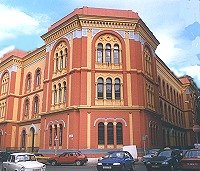On the eve of Tisha B’Av, commemorating the anniversary of the destruction of the First and Second Temples, artifacts were exposed that breathe new life into the story of the destruction of the Temple in Jerusalem.
Kétezer éves kardot és menoravésetet találtak Jeruzsálemben A vasfegyver bőrtokban pihent, a Siratófaltól nem messze.
A vasfegyver bőrtokban pihent, a szakemberek még annak az övnek a részeit is
feltárták, amelyre a kardot csatolták. A kard minden bizonnyal római katonáé
lehetett.
A mintegy hatvan centiméter hosszú fegyvert a Siratófal
közelében, egy antik csatornában fedezték fel – tudatta az izraeli régészeti
hivatal. A júdeai római uralom idején a jeruzsálemiek gyakran bújtak el
menekülés közben a csatornákban – emlékeztettek szakemberek.
A munkálatok
során találtak egy olyan követ is, amely egy ritka menoravésetet visel magán. A
kődarabon látható hétágú gyertyatartó feltételezések szerint abban a Második
Templomban volt látható, amelyet a rómaiak i.sz. 70-ben romboltak le.
A sword in a scabbard that belonged to a Roman soldier and an engraving of
the Temple’s menorah on a stone object were discovered during work the Israel
Antiquities Authority conducted in the 2,000 year old drainage channel
between the City of David and the Jerusalem Archaeological Garden.
The channel served as a hiding refuge for the residents of Jerusalem from the
Romans during the destruction of the Second Temple.
During the course of work the Israel Antiquities Authority carried out in
Jerusalem’s ancient drainage channel, which begins in the Siloam Pool and runs
from the City of David to the archaeological garden (near the Western Wall),
impressive finds were recently discovered that breathe new life into the story
of the destruction of the Second Temple. The excavations are being conducted on
behalf of the Israel Antiquities Authority, in cooperation with the Nature and
Parks Authority and are underwritten by the City of David Foundation.

The
sword with remains of the scabbard on it (Photo: Clara Amit, courtesy Israel
Antiquities Authority)
A 2,000 year old iron sword, still in its leather scabbard, was discovered in
work the Israel Antiquities Authority is doing in the channel, which served as a
hiding refuge for the residents of Jerusalem from the Romans at the time of the
Second Temple’s destruction. In addition, parts of the belt that carried the
sword were found.
According to the excavation directors Eli Shukron of the Israel Antiquities
Authority and Professor Ronny Reich of the University of Haifa, „It seems that
the sword belonged to an infantryman of the Roman garrison stationed in Israel
at the outbreak of the Great Revolt against the Romans in 66 CE. The sword’s
fine state of preservation is surprising: not only its length (c. 60 cm), but
also the preservation of the leather scabbard (a material that generally
disintegrates quickly over time) and some of its decoration”.
 The stone engraved with the image of the menorah (Photo: Vladimir Naykhin) |
A stone object adorned with a rare engraving of a menorah was found in the
soil beneath the street, on the side of the drainage channel. According to
Shukron and Professor Reich, „Interestingly, even though we are dealing with a
depiction of the seven-branched candelabrum, only five branches appear here. The
portrayal of the menorah’s base is extremely important because it clarifies what
the base of the original menorah looked like, which was apparently tripod
shaped”.
The fact that the stone object was found at the closest proximity to the
Temple Mount to date is also important. The researchers suppose a passerby who
saw the menorah with his own eyes and was amazed by its beauty incised his
impressions on a stone and afterwards tossed his scrawling to the side of the
road, without imagining that his creation would be found 2,000 years later.














